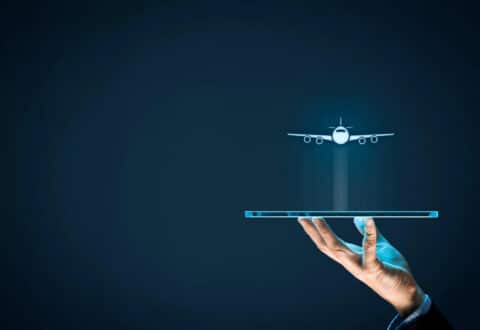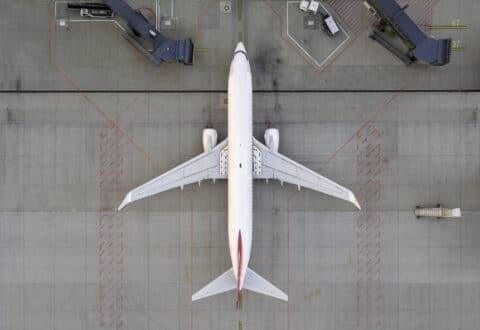Whether the goal is to retain existing customers or to attract new ones, aviation marketing strategies are the order of the day for any savvy airline marketing teams. Customers who fly with an airline put not only the success of their business and personal trips in the hands of their chosen airlines, but also their wellbeing and comfort. But when the essential experience comes down to minute differences, the marketing plan for aviation and aerospace goals becomes immeasurably more important and scrutinized.
Read on for 11 aviation marketing strategies that pull in more customers and boost revenue:
Please note that marketing strategies used in the aerospace and aviation industries are similarly effective, and as such, for the purposes of this article, the terms “aviation” and “aerospace” will be used synonymously.
1. Loyalty Programs Create Loyal Customers
A business that offers a loyalty program is more likely to get repeat business. People are naturally “collectors.” They collect all sorts of things, and they derive pleasure from collecting, whether they do it subconsciously or not, and the things they collect do not have to be tangible in any way to elicit that satisfaction.
For instance, buying a cup of coffee from a coffee shop where the barista stamps it and gives you a loyalty card makes you more likely to return, even if the price goes up.
It does not cost more, and may even cost less, to get your coffee elsewhere, but that stamp card is a physical reminder that you’ve been to your favorite shop three times in a row. The sunk cost fallacy is very prevalent in the human psyche, and a well-thought-out marketing strategy will exploit this tendency. This comes to life in aerospace marketing in the form of air miles or a rewards program that offers benefits to repeat customers.
- Marketing plans for aviation companies that use loyalty programs create loyal customers.
- Airline advertising that reaches their target audience and offers them a personalized experience and airline advertising that makes a connection and is memorable.
- Companies use these programs to offer benefits, rewards and points that can be used for further purchases.
- This has helped airlines build robust aviation marketing strategies that help them grow and expand their business.
- These aviation marketing strategies not only pave the way for boosting profits, but also allows the customer to get discounts in the future and on other services.
- A flashy and inviting lounge where travelers would like to hang out, conveniently next to the bland and relatively uncomfortable common space within an airport, can make travelers consider flying with your airline for their next trip.
- Offering a faster (or free) in-flight Wi-Fi option on the in-flight Wi-Fi startup screen is an excellent way to show existing or one-time customers the benefits of enrolling in the loyalty program.
2. Existing Customers Deserve Attention and Appreciation
It is always easier to keep a current customer than it is to attract a new one, especially those potential new customers who may otherwise be loyal to a competitor. Offering perks such as a loyalty program will not only attract new customers, but also help retain existing ones.
- Airports are expensive, so providing small snacks, the use of a shower, or even simply a space to store belongings during a long layover can add monetary value to your customers’ experience.
- Additionally, allowing loyalty members to choose how they want to use their “points” instead of providing a specified set of benefits can make them feel confident that the airline is tailoring the experience for them specifically.
- Some people may want to board early, whereas others don’t have much of an opinion about early boarding, so that perk would not add any benefit to them.
- Providing a menu of different perks not only allows a customer to choose which perks to use, but also gives them an incentive to “work” toward a certain perk.
- Perhaps they would rather have a free drink on the flight than have early boarding for those same 50 points. Maybe they’d like a seat upgrade for 200 points. Or maybe they’d still rather save their perks to use for various services in the airline’s lounge or even toward a discounted flight later. Whatever they are, options always feel more valuable than a set of predetermined benefits.
3. Social Media Campaigns That Start Conversations
A business without a social media platform is generally not seen as trustworthy. It looks like the business does not care enough about its customers to put effort into a space where they can easily get information and provide quick feedback.
Because of this, it is crucial for airline marketing campaigns to design stunning social media campaigns to get the most benefit out of them, and that starts with visibility. Providing not only informational but useful airline content is an excellent jumping-off point.
- Infographics about what a novice flier might find helpful to bring with them or about unnecessary items.
- Tips and tricks for getting through an airport or making the overall hassle of flying easier are great topics that many consumers will find share-worthy.
- When you take it a step further and make it beautiful and well-thought-out, it adds a certain touch that grabs people’s attention and makes them wonder who created it.
- Having a consistent brand style guide across all social media platforms is also vital for brand positioning.
4. Focus on Connections, Not Advertisements
In the same vein as digital marketing campaigns that provide value to customers, aviation marketing content that allows for real connections with people instead of simply advertising will always be more appealing to consumers.
- Adding information that is genuinely useful to your customers and not simply an advertisement is a great way to build connections.
- Consider allowing for honest customer reviews on whatever platform you decide to use is crucial to lending credibility and validity to your customer-focused claims.
- Respond to your reviews and publicly try to remedy any bad situation that arises, instead of moderating them or telling a reviewer to send a message to discuss the issue privately.
- Transparency goes a long way toward building trust with consumers, and an extra bit of grace tends to be given to companies that handle reviews effectively.
- Engage with your followers on social media. Customers care more about a brand that cares about them.
5. The Influence of Influencers
“Influencers” have a certain derogatory reputation in the United States, but don’t forget that they exist for a reason: they can influence their audiences. If they didn’t have an audience, they wouldn’t be successful.
- Partnering with successful influencers who have a reputation for honest reviews can be an excellent way to grow your customer base..
- It can be a simple and inexpensive airline marketing tactic to provide the influencer free travel in exchange for a certain number of posts about the benefits of using your airline.
- This can also mean a full-on partnership involving endorsements and specific metrics for engagement for payment.
- As long as you select a reputable influencer whose usual content aligns well with air travel, you cannot go wrong by partnering with an influencer as part of your marketing strategy.
6. Stories, Not Simply Words
Your social media and advertising in general should tell a story. While there is an obvious need to give important and pertinent information regarding the services offered, sharing a story can make your airline feel more relatable to consumers.
- Testimonials from customers about a special experience they have had with the airline can provide a great deal of engagement.
- If there is a parent of a special needs child, they can be highlighted with an anecdote regarding how accommodating the staff was for their child and how it made their experience more pleasant.
- Individual staff members can also be highlighted — maybe a first-time flier was scared, but a staff member was particularly compassionate and helped them through their fear.
There are hundreds of examples of these interactions that could be used for this purpose, and posts with purposes like these are often shared amongst like-minded consumers, so they go a lot farther than just your social media page.
7. Customer Service for the Digital Space
Flaunt your customer service options. Consumers want consistent and reliable customer service at their fingertips. Sure, there are those consumers who will still make a phone call to ask a question, but most people don’t want to meander through a phone tree for simple information.
They would much rather find the solution without speaking to anyone. Offering well-trained artificial intelligence or even human customer service in a chat application or on your website, as well as self-help options, can go a long way toward customer satisfaction. This can also help to eliminate some of the crowds at customer service desks and kiosks in the airport itself.
8. Smartphones Are a Mainstay
Simply put, smartphones are life. If it cannot be done on a smartphone, it is unlikely to get done these days. Consumers rely heavily on their smartphones when they travel and use digital applications for everything from navigation to weather to pre-ordering lunch — so they can grab it on their way through the airport to hailing a ride.
- Airlines need to keep all of this in mind and create an optimized website and mobile application that can be easily used from a smartphone.
- With the way our society is moving away from printed documents in general, including their identification and payment methods, these apps should feature digital ticketing as well as updates to flight schedules, baggage handling, etc.
- Additionally, these apps are a great place for your customers to access your loyalty program, with an interface that can allow them to easily see their points balance and trade points for rewards.
9. Omnichannel Media Is Everything
It is important to recognize that people utilize different social media and digital platforms, and therefore, it is crucial for your company to do the same if you want your message to be seen. It is often sufficient to copy and paste the same message across all of your social media platforms.
- Aviation companies must try to create unique content for each separate platform from time to time.
- A simple Facebook post with an infographic about what to bring to the airport with you, a LinkedIn blog written by one of your executives, or a TikTok video of one of your flight attendants getting ready for their day — this type of content adds value and will draw in a different audience.
- Encouraging your customers to interact with the company on social media is a great way to boost engagement.
- An email reminding them to leave a review or to tag you in photos they take on your plane with a specific hashtag, to provide a background for a selfie space with your company’s logo — you can utilize the social media of your customers themselves for advertisement.
10. Global Airline Marketing Strategies Aren’t Forever
As important as it is to have a global marketing strategy, it isn’t enough to create one and forget it. The world is ever-evolving, and those changes matter in the grand scheme of things and can have a major impact on not only who a target audience may be, but how well that target audience receives your content.
- What is the advertising norm in other countries you operate in?
- What is going on in each of the countries where you operate?
- What works in one country may not work in others, and marketing campaigns need to be tailored to each market.
Unless your company operates solely in one country, the cultures from around the world need to be considered.
11. Travelers Love Stopovers
Stopovers are more popular than ever. People love to travel, and they tend to post all over their social media about traveling, so the more places they can visit, the better. More and more people are seeking and taking advantage of long layovers to play tourist in a popular or beautiful vacation area, instead of opting for the quickest layover possible.
- Offering a discount for these stopover flights is an excellent way to attract customers who enjoy traveling and have a desire for quick adventure outings, while also saving money by allowing flexibility in your flight plans and routes.
- These stopovers could even be linked to your customer loyalty program, be it for an added discount for taking one or potentially partnering with a local travel agent who can provide discounted excursions.
It is increasingly important in today’s world to consider how a consumer may relate to the organization and react to advertising when creating a marketing plan for aviation. There are more advertising channels than ever and learning how to utilize them to the utmost benefit of your company is crucial to the success of any good marketing plan.
Want Your Airline Marketing Strategies to Soar?
Contact us today to chat about how Communications Strategy Group® can help you level up and maximize your marketing presence.


